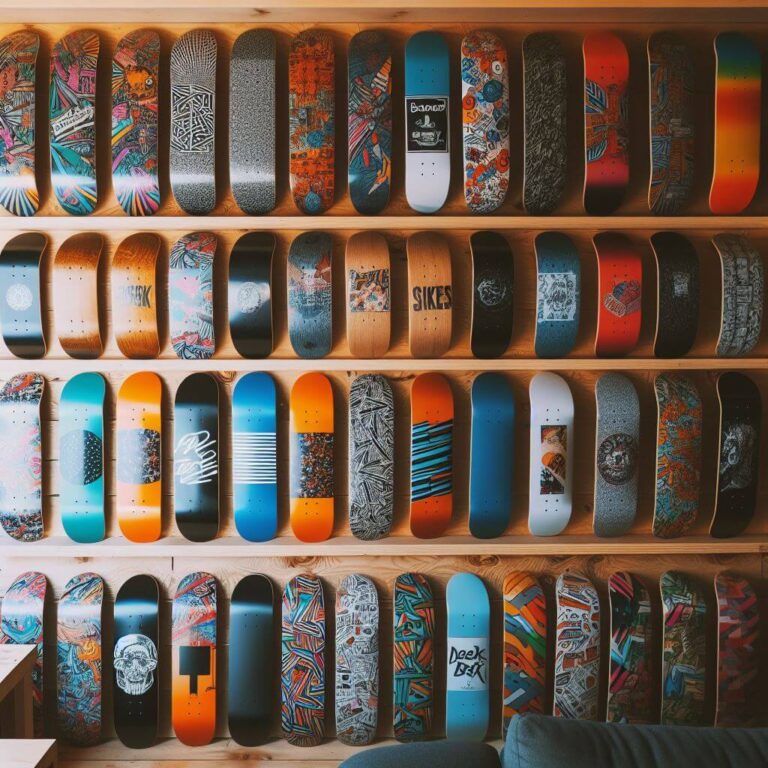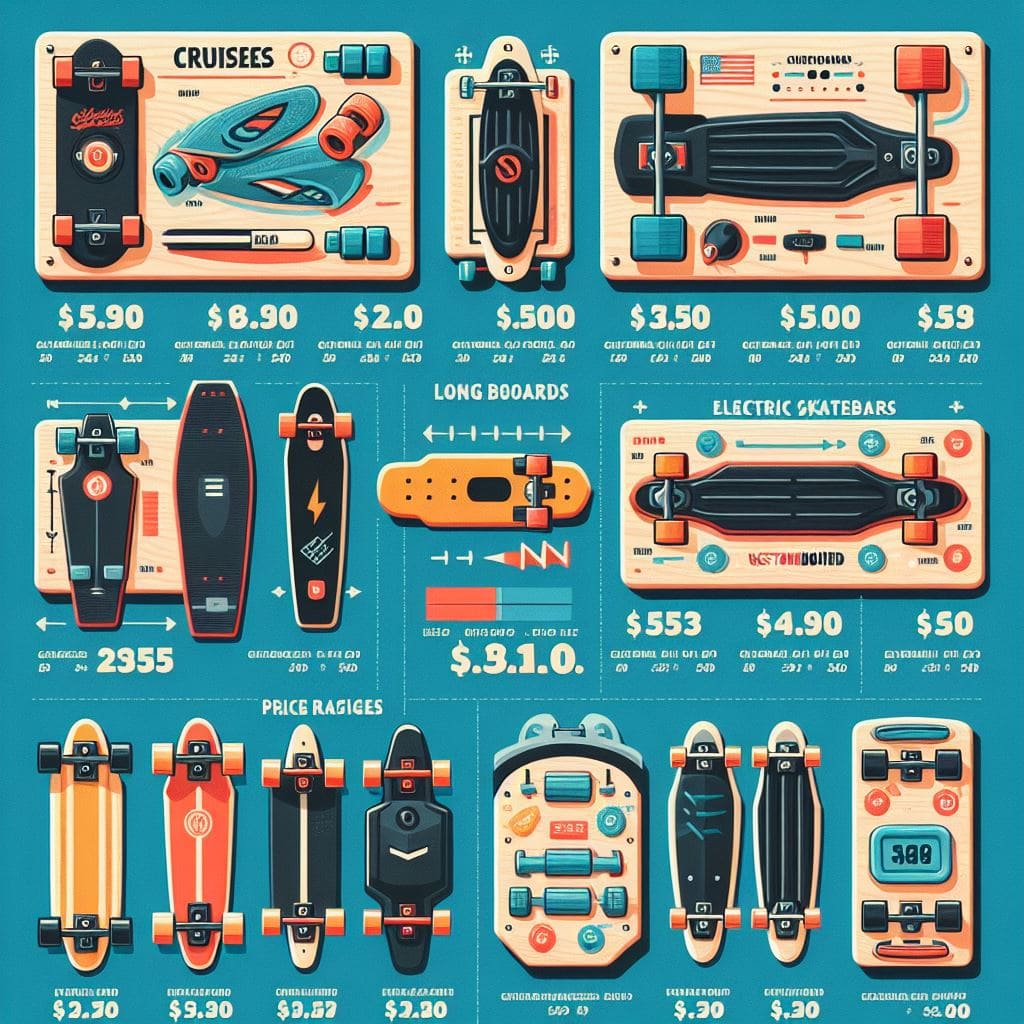Have you ever wondered how much does a skateboard deck weigh? Understanding this is more important than one might initially think. The skateboard deck’s weight profoundly influences the overall performance, trick execution, and comfort during the ride.
Before discussing skateboard deck weights, let’s briefly review the factors affecting them. The weight of a skateboard deck is largely determined by a careful balance of elements such as the material used, its size, the design specifics, and even the graphics painted onto it.
In the world of skateboarding, every ounce counts. A lighter board can be easier to manoeuvre and perform tricks with but might also sacrifice stability. Conversely, a heavier deck may lend a more stable ride but be more difficult for airborne stunts. It’s about finding that sweet spot, a unique journey for every rider.
Understanding Skateboard Decks
Embarking on the thrilling adventure of skateboarding, the deck emerges as the pivotal element, the very foundation upon which riders etch their path. The deck’s design, its materials, and the very essence of its construction weave a tale about its performance on the streets and ramps.
A skateboard deck is a flat, longboard to which the wheels and trucks are attached. The part of the skateboard you stand on is the primary determinant of how much the skateboard weighs. The skateboard deck has evolved significantly over the years, made primarily from plies of wood (commonly 7-layered maple) or sometimes from alternative materials like bamboo or even plastics. Each skateboard deck type promises a distinct balance, weight, and experience for the skater.
As you venture into the realm of skateboard decks, you’ll discover a rich variety that caters to every style and preference. From the robust and enduring street decks, perfect for flip tricks and street skating, to the nimble and lightweight decks engineered for high-flying aerial tricks, each deck type offers a unique balance, weight, and experience. Longboard decks, with their heavier and elongated construction, provide stability at high speeds, showcasing the versatility of skateboard decks.
The choice of deck is not a one-size-fits-all. The weight of a skateboard deck can vary largely depending on these types:
- Standard street decks usually weigh between 2 to 5 pounds. A classic choice, they balance weight and durability for an all-around versatile experience.
- Cruiser decks often shave off a few ounces for easier commuting and manoeuvrability in urban environments.
- Due to their larger size, longboard decks often weigh more, approximately 7 to 8 pounds, providing a more grounded experience.
- Freestyle decks, designed for creativity and innovation in skating techniques, can vary significantly in weight depending on the specific design features each skater desires.

Next, we delve into how these different types subtly or substantially affect weight. Street decks are predominantly designed for the wear-and-tear of urban skateboarding environments. Made to withstand impact, these decks are thick and sturdy but balanced enough not to impede aerial stunts. Cruiser decks, with a nod to comfort and ease, might use a different wood ply or construct to reduce weight for a user-friendly experience.
Longboard decks, synonymous with speed and fluidity, reflect their purpose in their weight and build. Engineered for long distances and downhill bombing, these decks need extra weight for stability and often boast a wider base. Freestyle decks, a relatively newer trend, embrace the innovative spirit of skateboarding, incorporating technology and unique materials that can push the boundaries of conventional deck weights.
The production of skateboard decks is not just about performance, it’s about sustainability and environmental impact. Many brands are leading the way in creating environmentally friendly decks, using sustainable wood or composites. These decks might offer lighter or comparable weights, but they also speak to a broader agenda in the manufacturing ethos of skateboarding culture, inspiring us all to consider the environmental footprint of our choices.
Skateboard decks are not just tools, they are a reflection of your purpose and preference. For those who thrive on executing complex tricks in the park, the deck’s weight becomes a crucial factor for mid-air manoeuvring. For long-distance cruisers, a heavier, more durable build is the ideal choice. Ultimately, the deck is a personal decision that shapes how you interact with the obstacles and opportunities under your wheels, making your skateboarding experience truly unique.
Factors Affecting the Weight of a Skateboard Deck
Sk skateboarding hinges on precision, where even the slightest nuances in equipment can amplify or dampen a skater’s performance. Among these, the weight of a skateboard deck holds paramount importance, influenced by a tapestry of factors, each interweaving to craft the final form. Let’s delve into the core elements that shape this crucial characteristic:
- Materials Used in Production: The choice of material is the cornerstone in determining the deck’s weight. Traditionally, skateboard decks are crafted from maple wood, which is renowned for its resilience and durability. A standard deck comprises seven to nine pieces of this wood pressed together. Yet, with technological advancements, materials such as bamboo, fibreglass, and even carbon fibre are being introduced. These materials can significantly reduce the weight, offering a lighter ride without compromising strength. Bamboo, for instance, is lighter than maple and has a natural flexibility that some skaters prefer for its distinct ride feel.
- Size and Shape of the Deck: It’s intuitive to understand that larger decks require more material and thus weigh more. Beyond the basic length and width, the shape of the deck also plays into its weight. Deeper concaves and elaborate shapes with cutouts can affect the weight. Wider decks provide more stability but at the cost of increased weight, which could affect manoeuvrability and trick performance for some riders.
- The Role of Graphic Prints: While seemingly negligible, the graphic print applied to the deck can also affect its weight. Screen printing and other traditional methods add minimal weight. However, elaborate graphics and protective layers to preserve these designs can add extra mass to the deck. In the grand scheme, this may be minuscule, but every gram counts for professional athletes.
- Manufacturing Process: How a deck is manufactured – including the adhesive used to bond the plies, the pressure applied during the pressing process, and post-production treatments such as waterproofing – can also influence its weight. High-pressure pressing can result in a denser, slightly heavier deck, which might offer more durability and resistance to snapping.
The interplay of these factors culminates in a deck’s final weight, presenting a broad spectrum for skaters to choose from based on their personal needs and skating style.
- Material impact: From the steady and durable maple to the flexible and light bamboo, the choice of material greatly defines the deck’s persona.
- Deck dimensions: The overall size, including length, width, and wheelbase, tailors the deck to specific skateboarding styles and affects weight and functionality.
- Aesthetics with a weight: Even the artistic flair, through graphics and design aesthetics, albeit minimally, tips the scale.
- Craftsmanship’s weight: The nuanced processes of manufacture, from ply adhesion to waterproofing, subtly but surely mould the deck’s mass and, with it, its story.
Understanding these factors is crucial for skaters to make informed choices. Whether prioritizing agility and ease for street tricks or desiring stability and endurance for long rides, the deck’s weight is a fundamental consideration.
As skateboard technology evolves, the materials and processes affecting deck weight will also transform, giving skaters more choices to customize their ride to perfection.
Average Weights of Skateboard Decks
Understanding the nuanced details of your equipment can be the key to unlocking new levels of performance and enjoyment in the pursuit of mastering skateboarding. Among these details, the weight of a skateboard deck is often a focal point for both novice and experienced skaters alike. Here, we explore the average weights of various skateboard decks, providing a compass for those navigating the spectrum of options available.
The weight of a skateboard deck is not a static figure; rather, it fluctuates based on several factors, such as material, size, and construction. However, to provide a general understanding, we draw upon common categories within the skateboarding world to outline average weights.
- Street Decks: The stalwart of the skateboarding decks, street decks are designed with versatility and durability. They averagely weigh between 2 to 5 pounds (0.9 to 2.3 kg). The variance within this range can often be attributed to the deck’s width and the number of pieces of wood used in its construction.
- Cruiser Decks: Tailored for comfort and seamless city navigation, cruiser decks tend to be slightly lighter than their street counterparts, averaging around 2 to 4.5 pounds (0.9 to 2 kg). Their design sacrifices a bit of the thickness in street decks for ease of transport and manoeuvrability.
- Longboard Decks: Known for their stability at high speeds and suitability for long-distance cruising, longboards understandably weigh more due to their larger size. The weight of longboard decks typically ranges from 7 to 8 pounds (3.2 to 3.6 kg), making them the heaviest among the common types of skateboards.
- Freestyle Decks: As the newest addition to the skateboarding family, freestyle decks are engineered for creativity and flexibility. Their weight can be quite variable, designed specifically to cater to the unique demands of each skater’s style. Generally, they range from 2 to 5 pounds (0.9 to 2.3 kg), similar to street decks, but with the potential for lighter and slightly heavier designs based on material and size.
These averages offer a broad overview, a starting point for skaters in their quest to find the perfect deck. However, it’s beneficial to remember that these figures represent more than mere numbers. The weight of a skateboard deck affects its performance, influencing factors such as ease of trick execution, the effort needed for propulsion, and the board’s overall stability.
- Street and Freestyle decks promise agility for tricks and flips, whereas a lighter build is often more desirable.
- Cruiser decks, balancing performance and portability, cater to skaters seeking comfort in their urban meanders.
- On the heavier side of the scale, longboards offer a sturdier platform for those looking to cruise, carve, or downhill confidently.
In summary, the weight of a skateboard deck is a tapestry weaved from various strands – its material, construction, and design. Understanding these aspects offers skaters the insight needed to select a deck that meets their practical needs and harmonizes with their skating style and preferences.
How to Choose the Right Skateboard Deck Weight
Selecting a skateboard is akin to picking a partner for dance – it must move with you, complement your rhythm, and support your performance. In the intricate ballet of skateboarding, the weight of your skateboard deck is a critical factor that can enhance or inhibit your moves. Let’s explore how to strike that perfect balance between your deck’s weight and your skating style.
Before stepping into a skate shop or pressing ‘add to cart’ online, it’s vital to reflect on your skateboarding habits and preferences:
- Evaluate Your Skating Style: Are you gliding through city streets, flipping tricks at the local park, or cruising down coastal boardwalks? Each style demands specific deck characteristics. Street and park skaters might prefer lighter decks that make aerial tricks easier, whereas cruisers may opt for more heft for stability and momentum.
- Consider Your Skill Level: Beginners may benefit from a slightly heavier deck that remains stable underfoot, helping them build confidence as they learn. Advanced skaters often know exactly what they need from their deck—whether it’s the light touch for technical tricks or a solid weight for rugged riding.
- Think About Comfort and Travel: Do you trek with your board in tow, or is it solely for shredding pavement? Weight becomes a practical consideration if you carry your skateboard over long distances. A lighter deck is far more portable, whereas heavier ones might offer a workout.
Once you’ve pondered these points, it’s time to navigate the scales. Here’s how:
- Deck Material: Lighter materials such as bamboo or carbon fibre can reduce weight without sacrificing strength. They offer a different flex and feel, which can complement certain styles of skateboarding.
- Deck Size and Shape: Larger, wider decks increase weight. However, if you seek stability in a board, a little extra weight could be beneficial. Conversely, a smaller, lighter deck is ideal for street skating and technical tricks.
- Graphic Layers and Coatings: While not a major contributor, graphic layers and coatings can add weight. Opt for a simpler design to keep their deck as light as possible.
- Construction and Technology: Some brands leverage advanced construction methods to reduce weight while maintaining deck integrity. Research brands that specialize in lightweight or performance-oriented decks.
- Personal Testing: Ultimately, nothing beats the experience of standing on a board and feeling its weight under your feet. If possible, visit a skate shop and test out different decks. This tactile interaction can provide invaluable insight into what feels right for you.
For an illustrative approach, comparison charts, diagrams, or an interactive tool to match deck types to skating styles can greatly enhance the reader’s undreader’sng and decision-making process.
Choosing the right skateboard deck weight is a highly personal decision. It considers one’s unique needs, body mechanics, and preferences. Whether you’re looking at your buoyant flips or steady cruises, remember – it’s about fitting that board that feels like an extension of yourself as you weave through the tapestry of skateboarding life.
Conclusion
As we come to the end of this journey exploring the nuanced world of skateboard decks and their weights, it’s clear that this aspect of skateboarding is far more complex than it appears at first glance. The weight of a skateboard deck affects not just the skateboard’s physical handling but also the skater’s psychological comfort, influencing confidence, style, and, ultimately, performance.
Choosing the right deck is a dance of balancing needs, desires, and practicalities. It’s about understanding the interplay between the deck’s weight and your skating style, ambitions, and preferences. The key takeaway is that there is no one-size-fits-all answer when selecting the perfect skateboard deck. It’s a personal decision, influenced by various factors including but not limited to the skater’s physical build, skating style, level of expertise, and the specific conditions in which they skate.
Throughout this exploration, we delved into the factors affecting the weight of the skateboard deck, providing insight into materials, manufacturing processes, and the role of size and shape. We then traversed the landscape of average weights across different skateboard decks, offering a template for skaters to start their selection process. Following this, we laid out guidelines for choosing the right deck weight, emphasizing the importance of personal preference and the necessity of aligning the deck’s characteristics with the skater’s needs.
Remember, the ultimate goal is to find a deck that feels like an extension of yourself – one that complements your moves, enhances your style, and supports your skateboarding journey. Whether launching into aerial tricks at the skate park, cruising down city streets, or simply enjoying the freedom of movement that skateboarding offers, the right deck can make all the difference.
Here are a few parting tips to guide you in your selection:
- Experiment: Don’t be afraid to try different deck weights and types. What works for one skater might not work for another.
- Consult: Leverage the knowledge of more experienced skaters or staff at skate shops. They can offer invaluable advice based on your style and needs.
- Invest: Consider investing in more than one deck if you enjoy different styles of skating. Having options can enhance your skating experience.
- Reflect: Always reflect on your own experiences. Your preferences can evolve just as you do as a skater.
You select a companion for your skateboarding adventures when choosing your skateboard deck. It’s a decision that merits consideration and care. The right skateboard deck doesn’t just carry you from point A to point B; it becomes a part of your expression in the skateboarding world, a tool through which you carve your path and leave your mark.
You may also want to read:
Unleash the Thrill: The Best Safety Gear for Electric Skateboarding Guide 2024
Maximize your electric skateboarding experience by ensuring your safety. Discover the best safety gear for…
Discover The Best Skateboard Brand To Perfect Your Skills
In search of the best skateboard brand? Dive into our comprehensive guide exploring top-rated skateboard…
Mastering Maintenance: A Comprehensive Guide on How To Maintain Skateboard Bearings
Learn all the tricks of the trade on how to maintain skateboard bearings. Keep your…





